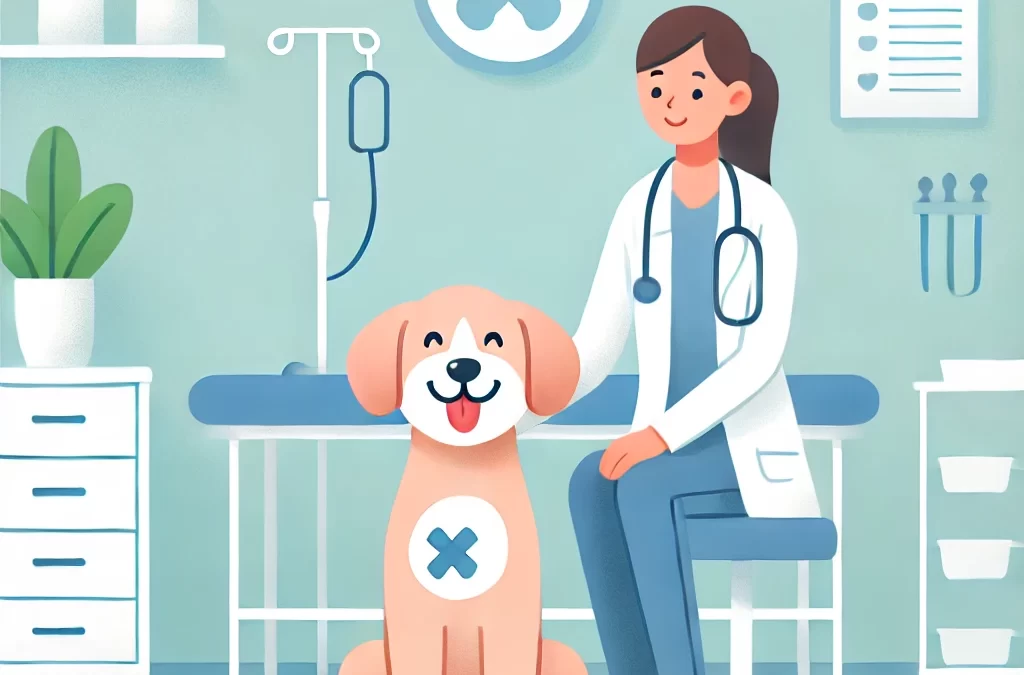
執筆者 TCMVET | 2024年11月27日 | 犬の癌と腫瘍
チギラノール チグラートは、特定の種類の犬の腫瘍に対する画期的な治療法であり、獣医腫瘍学に革命をもたらしました。ペットの飼い主がこの革新的な治療法を検討する中、その費用を心配する人が多くいます。しかし、費用に関する議論は金銭的な数字だけにとどまるものではありませんか? チギラノール チグラートの価値に関する独自の視点を掘り下げてみましょう。費用だけでなく、その見返りとして何が得られるかを見てみましょう。
チギラノール・チグラ酸について理解する
ブラッシュウッドの種子から開発されたチギラノールチグレート(Stelfonta® として販売)は、犬の肥満細胞腫に対する非外科的治療薬です。注射で投与すると、腫瘍細胞を破壊し、傷の治癒を促進し、数日以内に目に見える効果が現れます。この革新的な治療法は、年齢、健康状態、腫瘍の位置などの理由で手術が不可能な犬にとって特に魅力的です。
経済的コスト
チギラノールチグレートの価格は、いくつかの要因に応じて大きく異なります。
- 腫瘍の大きさ
薬の価格は、腫瘍の体積によって決まる投与量に基づいて決まる。腫瘍が大きいほど投与量も高くなり、コストも高くなる。
- 獣医費
治療にかかる費用には、治療前の評価、鎮静、治療自体、およびフォローアップケアが含まれます。これらの専門家の料金は、場所やクリニックによって異なります。
- 治療後のケア
多くの犬はすぐに回復しますが、中には追加の傷の管理が必要になる犬もおり、全体的な費用が増加する可能性があります。
平均的に、チギラノールチグレート治療の費用は $500から$2,500 上記の要因に応じて、またはそれ以上になります。
感情的なコスト
金銭的な出費は大きいですが、愛するペットの治療に伴う精神的負担も考慮する必要があります。チギラノール チグラートは侵襲的手術に代わる魅力的な治療法であり、ペットと飼い主の両方のストレスと回復時間を軽減します。
- 犬の不安を軽減
手術は、特に高齢の犬の場合、回復期間が長く、リスクも高くなることがよくあります。チギラノール チグラートは、これらの問題を最小限に抑え、より侵襲性の低いソリューションを提供します。
- オーナーの安心
腫瘍がリアルタイムで縮小していく様子を見るのは、精神的に満足できる体験です。多くの人にとって、目に見える即時の結果によってコストは正当化されます。
コストと価値
チギラノール チグレートの価格を評価する際には、その価値を考慮することが重要です。
- 生活の質: この治療は、手術に伴うリスクなしに犬の健康を維持し、向上させることに重点を置いています。
- 節約できる時間: 1 回の注射で治療できるため、長い回復期間が必要なくなることがよくあります。
- 感情的な安らぎ: 愛犬の診断の重荷に苦しんでいる飼い主にとって、急速な改善が見られることは非常に貴重です。
隠れた節約
初期費用は高額に思えるかもしれませんが、チギラノール チグレートは間接的な節約をもたらします。
- 手術に伴う合併症およびそれに伴う費用を回避します。
- 腫瘍管理のための継続的な治療や投薬の必要性が減少します。
- 早期介入による将来の腫瘍関連の問題の予防。
チギラノール チグレートの購入:ペットの飼い主のためのヒント
手頃な価格を気にする人のために、検討すべきヒントをいくつか紹介します。
- Pet Insurance: あなたの保険がチギラノール チグレートのような高度な治療をカバーしているかどうかを確認してください。
- Payment Plans: 多くの獣医クリニックでは、費用管理に役立つ分割払いプランを提供しています。
- 非営利団体への支援: ペットケアを専門とする団体は、緊急治療のための資金援助を提供することもあります。
- 今後の予算編成: ペットの健康管理のための資金計画を早めに立てておくと、予期せぬ出費の負担を軽減できます。
最終的な考え
チギラノール チグレートの費用は単なる数字ではありません。希望、革新、ケアの尺度です。この治療法はすべての予算に合うわけではありませんが、肥満細胞腫の治療に低侵襲で効果的な選択肢を提供することで、犬とその家族に比類のない価値をもたらします。多くの人にとって、問題は「費用はいくらか」ではなく、「治療を試みないことの代償はいくらか」です。
愛犬の治療を進める際には、治療費にはかかった費用だけでなく、一緒に過ごす時間も含まれることを忘れないでください。チギラノール チグラートは、より多くの犬がより健康で幸せな生活を送れる未来、つまり愛、長寿、そして友情への投資を表しています。

執筆者 TCMVET | 2024年11月27日 | 犬の癌と腫瘍
がんと診断された愛犬にいつ別れを告げるかを決めることは、ペットの飼い主が直面する最も難しい決断の 1 つです。ケースはそれぞれ異なりますが、この記事では、この感情的なテーマについて別の視点を提示し、愛、生活の質、そして手放す前に意味のある思い出を作ることに焦点を当てています。
愛犬の旅を理解する
がんを患った犬は、人間と同様に、さまざまな身体的、精神的状態を経験します。犬の状態を理解することで、情報に基づいた決定を下すことができます。
- 痛みのレベル: 痛みは多くの場合、最初の兆候です。緩和ケアの進歩にもかかわらず、犬によっては持続的な不快感を感じる場合があります。
- モビリティの問題: 犬が散歩や遊びなどの活動をまだ楽しめるかどうか観察してください。運動能力の低下は、生活の質の低下を意味する場合があります。
- 食欲の変化: 突然、食べたり飲んだりすることを拒否するということは、身体が機能停止していることを意味する可能性があります。
- 感情の変化: 犬は感情的な生き物です。あなたの犬が引きこもったり、不安になったり、周囲に興味を示さなかったりしているかどうかに注意してください。
新しいフレームワーク:「5つの喜び」アプローチ
衰えだけに焦点を当てるのではなく、犬の生活の質を評価するために次のアプローチを検討してください。自分自身に問いかけてください。
- 食べること: あなたの犬は今でも好きな食べ物を楽しんでいますか?
- 快適な睡眠: 痛みや苦痛の兆候もなく休んでいますか?
- 社会的交流: 彼らは仲間を求めているのでしょうか、それとも撫でられるのを楽しんでいるのでしょうか?
- プレイ中: 彼らは、たとえ限られた形でも、自分の好きな活動に取り組んでいますか?
- 探索中: 彼らは周囲の環境に興味を示していますか?
これらの喜びのうち 3 つ以上が継続的に失われている場合は、安楽死を検討する時期かもしれません。
別れを告げる:総合的なアプローチ
別れを告げることは、一つの章の突然の終わりのように感じる必要はありません。移行をスムーズにしながら、愛犬の旅路を尊重する方法は次のとおりです。
- バケットリストを作成する
喜びの瞬間を作り、愛犬の人生を祝いましょう。それは、愛犬のお気に入りの公園でピクニックをしたり、特別なおやつを分け合ったりするといった簡単なことでも構いません。
- 快適さを重視
落ち着いた、慣れ親しんだ環境を提供してください。心地よい寝具、優しいマッサージ、アロマセラピーなどを利用して、ストレスを和らげてください。
- 信頼できる獣医とコミュニケーションをとる
思いやりのある獣医師は、衰えの兆候を認識し、安らかな死を迎えるための計画を立てるのを手伝ってくれます。
- 自宅での安楽死を検討する
多くのペットの飼い主は、自宅での安楽死サービスを選択し、愛犬が慣れ親しんだ環境で、愛する人たちに囲まれて亡くなることを許しています。
- 彼らの遺産を守る
足跡の型や大切な写真のスクラップブックなど、記念品を作りましょう。愛犬の生涯を祝いながら悲しみを乗り越えるのに役立ちます。
最後の別れを再定義する
安楽死は単なる臨床的な決定ではなく、愛の行為です。愛犬を安らかに逝かせることを選択することは、愛犬に不必要な苦しみを与えず、愛犬の尊厳を尊重することにつながります。「いつ逝かせるか」に焦点を当てるのではなく、「愛犬の最期の瞬間をいかに意味のあるものにするか」に視点を移しましょう。
教訓:悲しんでも大丈夫
悲しみは、このプロセスにおける自然な一部です。それは、あなたが愛犬と共有していた深い絆の証です。あなたが経験していることを理解し、友人、家族、あるいはペット愛好家のオンライン コミュニティからサポートを求めてください。
結局のところ、決断は極めて個人的なものです。自分の直感を信じ、愛犬のユニークな旅路を尊重し、時間ではなく愛がペットとの関係を決めるということを理解してください。

執筆者 TCMVET | 2024年11月26日 | 犬の癌と腫瘍
ペットの飼い主が「腫瘍」という言葉を聞くと、腹にパンチを食らったような気分になります。疑問が次々と湧いてきます。「癌なのか?うちの犬は大丈夫なのか?」そして最も重要なのは、 何を手伝えばいいでしょうか? 現代の獣医学ではさまざまな治療法が提供されていますが、多くの飼い主は伝統的な治療を補完するために自然で総合的なアプローチに目を向けています。犬の腫瘍を管理し、縮小させるのに役立つ、革新的であまり知られていない選択肢をいくつか見てみましょう。
犬の腫瘍の性質
犬の腫瘍は、良性の脂肪腫から肥満細胞腫や骨肉腫などの悪性癌まで多岐にわたります。治療計画は腫瘍の種類、大きさ、進行度によって異なりますが、腫瘍に対処するには、従来の治療法(手術や化学療法など)と全体的な健康を高めるための支持療法を組み合わせることがよくあります。
しかし、ここに落とし穴があります。すべての治療が侵襲的であったり合成的である必要はありません。自然は、犬の健康をサポートしながら腫瘍を縮小させるのに役立つ資源の宝庫を私たちに提供してくれています。
栄養補給:食べ物は薬
- キノコのパワーハウス
薬用キノコ類 椎茸, 霊芝そして ターキーテール ベータグルカンが豊富に含まれており、免疫系を調整し、腫瘍の成長を遅らせる可能性があります。獣医腫瘍学の研究では、これらの菌類が特定の癌の進行を遅らせる可能性があることが示唆されています。犬の食事に粉末キノコサプリメントを少し振りかけると、状況が一変する可能性があります。
- ゴールデンペースト(ターメリックブレンド)
ウコンはその活性化合物で知られています。 クルクミン強力な抗炎症作用と抗酸化作用を持つクルクミン。いくつかの研究では、クルクミンは癌細胞の増殖を阻害することが示されています。ターメリックパウダーをココナッツオイルと黒コショウと混ぜて、犬に優しい黄金色のペーストを作りましょう。
- オメガ3脂肪酸
魚油や亜麻仁に含まれるオメガ 3 は、腫瘍の成長を遅らせ、全体的な健康をサポートする天然の抗炎症剤です。犬の食事にオメガ 3 を加えるだけで、シンプルながらも効果的な栄養補給になります。
腫瘍管理のための天然サプリメント
- CBDオイル
カンナビジオール (CBD) は、その抗腫瘍効果の可能性から注目を集めています。がん細胞にアポトーシス (プログラム細胞死) を誘導し、炎症を軽減すると考えられています。必ず THC を含まないペット専用の CBD オイルを選択し、適切な投与量については獣医に相談してください。
- エシアックティー
ゴボウ、ニレ、ヒツジスイバなどのハーブをブレンドしたエッサイア ティーは、腫瘍の自然療法として長い間使用されてきました。液体またはカプセルの形で提供されており、体内の毒素を除去し、異常な腫瘍を縮小させる効果があると考えられています。
- チュアンシオン(四川ラビジン)
あまり知られていないが、強力な伝統的な中国のハーブである川芎には、血行を改善し、炎症を軽減する特性があります。一部のホリスティック獣医師は、腫瘍を管理するためのハーブ療法の一部として川芎を推奨しています。
ホリスティックセラピー
- 鍼治療
鍼治療は腫瘍を直接縮小させるわけではありませんが、血流を改善し、痛みを軽減し、他の治療の効果を高めることができます。多面的なケアプランに追加すると効果的です。
- 高圧酸素療法(HBOT)
腫瘍は酸素の少ない環境で増殖します。高圧酸素療法は体内に酸素を充満させ、腫瘍の成長を遅らせ、治癒を促進する可能性があります。
ライフスタイルの調整
- 食生活の見直し
低炭水化物、高タンパク質の食事は、成長に糖分を必要とする特定の腫瘍を飢えさせることができます。犬の特定のニーズに合わせた生食または調理済みの食事を検討してください。
- ストレス軽減
慢性的なストレスは免疫系を抑制し、犬が病気と闘うことを困難にします。犬の環境が穏やかで、犬が楽しめるアクティビティが充実していることを確認してください。
- 環境の浄化
農薬、合成芳香剤、加工食品などの有害な化学物質への曝露を減らしてください。これらの環境毒素は犬の体に負担をかけ、回復を困難にします。
現代的アプローチと自然的アプローチを組み合わせる力
自然療法は素晴らしい効果をもたらしますが、すべての犬に単独で有効な解決策ではありません。統合的ケアを理解している獣医と協力することが重要です。これにより、あなたの犬は、現代医学の命を救う力と自然療法の優しいサポートという両方のメリットを確実に受けることができます。
明るい見通し
腫瘍の診断を受けた犬を助ける旅は、気が遠くなるような気がしますが、覚えておいてください。あなたは一人ではありません。食事の変更、天然サプリメント、ホリスティック療法を組み合わせることで、犬に闘うチャンスを与え、生活の質を向上させることができます。
時には、ほんの少しの変化、例えばターメリックを少し、キノコパウダーをスプーン一杯、CBDを一滴加えるだけでも、大きな違いが生まれることがあります。

執筆者 TCMVET | 2024年11月26日 | 食と健康
ペットの飼い主として、私たちは常に犬の健康を向上させる方法を探しています。魚油やグルコサミンなどの主流のサプリメントが広く使用されていますが、人気が高まっているユニークな選択肢が1つあります。 椎茸パウダーアジアの料理や医学で伝統的に崇拝されてきたこの古代のスーパーフードは、期待できる効果とともにペットの健康の世界にも進出しています。椎茸パウダーがあなたのペットにとって次のゲームチェンジャーとなるかもしれない理由を詳しく見ていきましょう。
椎茸パウダーとは?
シイタケ(Lentinula edodes)は、豊かなうま味と強力な健康効果で知られる食用菌類の一種です。この成分を細かく粉砕すると、犬の食事に簡単に加えられる万能サプリメントになります。ビタミンB、D、セレン、銅、多糖類などの必須栄養素が詰まったシイタケは、料理の楽しみ以上のものです。
犬にとっての驚くべき健康効果
椎茸パウダーは単なる流行りの食材ではありません。科学的に裏付けられています。椎茸パウダーが犬の健康を改善する方法をいくつかご紹介します。
- 免疫システムのサポート
シイタケには、免疫力を高める効果があることで知られる化合物、ベータグルカンが含まれています。これは、犬の感染症や病気に対する防御力を強化するのに役立つため、高齢犬や免疫力が弱っている犬に特に有益です。
- 抗炎症作用
あなたの犬が関節炎、アレルギー、またはその他の慢性炎症性疾患を患っている場合、椎茸に含まれる天然化合物は炎症を軽減し、快適さを促進するのに役立ちます。
- 抗酸化物質の宝庫
シイタケにはセレンなどの抗酸化物質が豊富に含まれており、犬の酸化ストレスと闘い、老化を遅らせ、慢性疾患のリスクを軽減することができます。
- 消化器系の健康
椎茸に含まれるプレバイオティクス繊維は、有益な細菌に栄養を与え、消化を改善し、栄養素の吸収を助けることで腸の健康をサポートします。
- がん予防とサポート
椎茸パウダーは、特にレンチナンなどの化合物による潜在的な抗がん作用で注目を集めています。治療薬ではありませんが、腫瘍と闘う犬にとって補助療法となる可能性があります。
犬に椎茸パウダーを与える方法
- 小さく始める
少量(小型犬の場合は小さじ1/4杯、大型犬の場合は小さじ1/2杯程度)を食事に混ぜて与え始め、犬が慣れてきたら徐々に量を増やしてください。
- 高品質のパウダーを選ぶ
ペット用に特別に配合された製品を使用していることを確認してください。オーガニック、無農薬、最小限の加工が施された粉末が最適です。
- 観察して調整する
消化や行動に変化がないか愛犬を観察してください。稀ではありますが、キノコに敏感な犬もいます。
倫理的ボーナス:持続可能性
椎茸パウダーの使用は環境に優しい慣行と一致しています。キノコ栽培には最小限の水と土地しか必要ないため、持続可能な選択となります。より多くのペットの飼い主が環境に配慮したライフスタイルを採用するにつれて、犬の食事に椎茸パウダーを加えることは、より環境に優しい未来への小さな一歩となる可能性があります。
誤解を解く:キノコは犬にとって安全か?
多くのペットの飼い主は、毒性を懸念して「キノコ」と聞くと躊躇します。野生のキノコの中には危険なものもありますが、シイタケなどの栽培種は適度に与えれば犬にとって完全に安全です。いつものように、新しいサプリメントを与える前に獣医に相談してください。
犬用椎茸パウダーレシピ
食事の時間を楽しくするために、椎茸パウダーを犬の食事に取り入れる簡単な方法をいくつかご紹介します。
- 椎茸ふりかけ: 犬の通常のドライフードまたはウェットフードに少量の粉末を振りかけます。
- ゴールデンペースト: 抗炎症効果を高めるために、椎茸パウダーをターメリック、ココナッツオイル、水と混ぜます。
- 手作りのおやつ: オート麦粉、ピーナッツバター、小さじ1杯の椎茸パウダーを使ってドッグビスケットを焼きます。
結論: スーパードッグのためのスーパーフード
椎茸パウダーは単なるサプリメントではありません。犬の健康に対する総合的なアプローチです。免疫力の向上から腸の健康のサポートまで、その天然の利点は、他のサプリメントではほとんど得られない方法で犬の食事を補うことができます。
では、普通の食べ物から離れて、このユニークなスーパーフードを試してみてはいかがでしょうか。あなたの犬は尻尾を振って、より健康的な生活を送ってくれるかもしれません。
執筆者 TCMVET | 2024年11月25日 | 食と健康
薬用キノコから抽出された多糖類ペプチド (PSP) は、人間にとって驚くべき健康効果があると長い間称賛されてきました。現在、犬の健康のための画期的なサプリメントとしての可能性に注目が集まっています。これらの強力な化合物の濃縮形態である細胞性 PSP は、犬の免疫力を高め、慢性疾患と闘い、全体的な健康を向上させる総合的なアプローチを提供します。
セルラー PSP とは何ですか?
細胞性PSPは、次のような薬用キノコから抽出された生理活性化合物です。 トラメテス・バーシコロル (ターキーテール)と 霊芝 (霊芝) 多糖類とペプチドが相乗的に作用し、免疫調節、抗炎症、抗酸化作用を発揮します。これらの特性により、慢性疾患、癌、免疫関連の症状に悩む犬の健康管理に貴重な追加成分となります。
セルラーPSPが犬にもたらすメリット
免疫システムのサポート
細胞性 PSP は天然の免疫調節剤で、犬の免疫防御を調節し強化するのに役立ちます。特に次のような犬に効果的です:
- がん: ナチュラルキラー(NK)細胞の活性を高め、白血球を刺激することで、体が腫瘍と闘うのを助けます。
- 慢性感染症: 細胞性 PSP は免疫反応を高めることで持続感染症と戦うのに役立ちます。
抗がん作用
PSP に関する研究では、腫瘍の成長を抑え、生存率を向上させるという有望な結果が示されています。犬の場合、これは次のことを意味します。
- リンパ腫、骨肉腫、肥満細胞腫などの癌の進行を遅らせます。
- 疲労や免疫力の低下などの化学療法の副作用を軽減します。
抗炎症効果
慢性炎症は、関節炎や胃腸障害など、犬の多くの病気の根本的な原因です。PSP は細胞レベルで炎症を軽減し、以下の症状を緩和します。
- 関節の痛みとこわばり。
- 炎症性腸疾患(IBD)などの消化器系の問題。
抗酸化保護
細胞性 PSP の抗酸化特性はフリーラジカルを中和し、細胞の損傷を防ぎ、全体的な健康をサポートします。これは、加齢に伴う疾患につながる酸化ストレスの影響を軽減するため、高齢犬にとって特に有益です。
セルラー PSP はあなたの犬に適していますか?
Cellular PSP の利点は多岐にわたりますが、犬の食事に取り入れる前に獣医に相談することが重要です。特定の健康状態にある犬や化学療法を受けている犬の場合、最適な結果を得るためには投与量を調整する必要があります。また、純度と効能を確保するために、常に信頼できるソースから PSP サプリメントを選択してください。
結論
Cellular PSP は、自然療法と現代科学のギャップを埋める、犬の健康に対する最先端のアプローチです。免疫力をサポートし、炎症を軽減し、抗酸化保護を提供することで、この強力なサプリメントは犬の生活の質を高めることができます。予防策として使用する場合でも、より広範な治療計画の一部として使用する場合でも、Cellular PSP はあらゆる年齢の犬に希望と総合的な治癒をもたらします。




